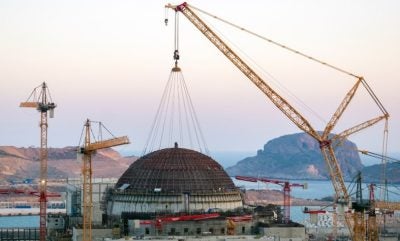
Russian and Turkish specialists have installed the dome of the outer containment (NZO – Naruzhnoi Zatsitnoi Obolochki) at unit 1 of the Akkuyu NPP under construction in Türkiye. This is the final element of the NZO, which is one of the physical barriers providing protection.
The 147.6-tonne dome has a diameter is 34.7 metres. The installation, involving 30 Akkuyu specialists, took six hours and was carried out using the world’s most powerful self-propelled caterpillar crane.
“The dome of the outer containment shell was mounted in the designed position at an altitude of between 57.1 and 65.4 metres, noted Sergei Butskikh, General Director of project company Akkuyu Nukleer. “The NZO will ensure the reliability and safety of the reactor building. Its durable steel construction can withstand extreme environmental stresses and combinations thereof. The next stage will be concreting the NZO metal structure with high-strength concrete mortar. This will allow us to begin installing the heat removal system equipment.”
Akkuyu specialists put together the metal frame of the outer protective shell of the dome. Both tiers are welded together. The final weight of the domed part is almost 500 tonnes. The wall thickness after concreting will be 1.5 metres. The NZO is formed from reinforced concrete and is designed to withstand earthquakes of up to 9 points on the MSK-64 scale, hurricanes with a force of up to 60 m/s, tsunamis with waves up to 10 metres high.
Russian VVER-1200 reactors are equipped with a system of double (outer and internal) containment that ensure the maximum level of safety for the NPP and provides additional strength to the reactor building. In addition to the NZO, there is also an internal containment (VZO – Vnutrennei Zatsitnoi Obolochki). This ensures the tightness of the reactor building and serves as a support for pipelines, a polar crane, with which, during NPP operation reactor maintenance operations are performed.
Akkuyu, Türkiye’s first NPP, will eventually host four Russian-designed VVER-1200 reactors. The pouring of first concrete for unit 1 took place in April 2018, for unit 2 in June 2020, for unit 3 in March 2021, and for unit 4 in July 2022. Rosatom is constructing the reactors according to a build-own-operate model. Unit 1 is expected to begin operation in 2025. In July Akkuyu NPP reported that some 70% of the equipment and systems installed at unit 1 had already undergone commissioning.
Researched and written by Judith Perera






